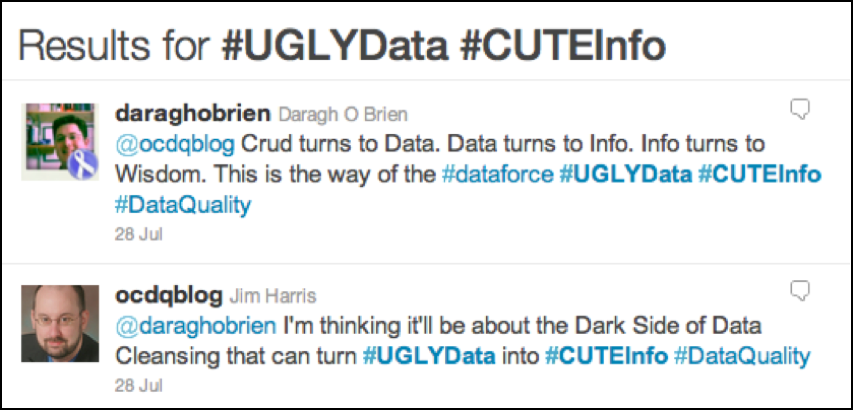Are you turning Ugly Data into Cute Information?
/
Sometimes the ways of the data force are difficult to understand precisely because they are sometimes difficult to see.
Daragh O Brien and I were discussing this recently on Twitter, where tweets about data quality and information quality form the midi-chlorians of the data force. Share disturbances you’ve felt in the data force using the #UglyData and #CuteInfo hashtags.
Presentation Quality
Perhaps one of the most common examples of the difference between data and information is the presentation layer created for business users. In her fantastic book Executing Data Quality Projects: Ten Steps to Quality Data and Trusted Information, Danette McGilvray defines Presentation Quality as “a measure of how information is presented to, and collected from, those who utilize it. Format and appearance support appropriate use of the information.”
Tom Redman emphasizes the two most important points in the data lifecycle are when data is created and when data is used.
I describe the connection between those two points as the Data-Information Bridge. By passing over this bridge, data becomes the information used to make the business decisions that drive the tactical and strategic initiatives of the organization. Some of the most important activities of enterprise data management actually occur on the Data-Information Bridge, where preventing critical disconnects between data creation and data usage is essential to the success of the organization’s business activities.
Defect prevention and data cleansing are two of the required disciplines of an enterprise-wide data quality program. Defect prevention is focused on the moment of data creation, attempting to enforce better controls to prevent poor data quality at the source. Data cleansing can either be used to compensate for a lack of defect prevention, or it can be included in the processing that prepares data for a specific use (i.e., transforms data into information fit for the purpose of a specific business use.)
The Dark Side of Data Cleansing
In a previous post, I explained that although most organizations acknowledge the importance of data quality, they don’t believe that data quality issues occur very often because the information made available to end users in dashboards and reports often passes through many processes that cleanse or otherwise sanitize the data before it reaches them.
ETL processes that extract source data for a data warehouse load will often perform basic data quality checks. However, a fairly standard practice for “resolving” a data quality issue is to substitute either a missing or default value (e.g., a date stored in a text field in the source, which can not be converted into a valid date value, is loaded with either a NULL value or the processing date).
When postal address validation software generates a valid mailing address, it often does so by removing what it considers to be “extraneous” information from input address fields, which may include valid data accidentally entered in the wrong field, or that was lacking its own input field (e.g., e-mail address in an input address field deleted from the output valid mailing address).
And some reporting processes intentionally filter out “bad records” or eliminate “outlier values.” This happens most frequently when preparing highly summarized reports, especially those intended for executive management.
These are just a few examples of the Dark Side of Data Cleansing, which can turn Ugly Data into Cute Information.
Has your Data Quality turned to the Dark Side?
Like truth, beauty, and singing ability, data quality is in the eyes of the beholder, or since data quality is most commonly defined as fitness for the purpose of use, we could say that data quality is in the eyes of the user. But how do users know if data is truly fit for their purpose, or if they are simply being presented with information that is aesthetically pleasing for their purpose?
Has your data quality turned to the dark side by turning ugly data into cute information?
Related Posts
Data, Information, and Knowledge Management
Beyond a “Single Version of the Truth”
The Data-Information Continuum
Data Quality and the Cupertino Effect
OCDQ Radio - Organizing for Data Quality
Amazon’s Data Management Brain
Holistic Data Management (Part 3)
Holistic Data Management (Part 2)
Holistic Data Management (Part 1)
OCDQ Radio - Data Governance Star Wars


